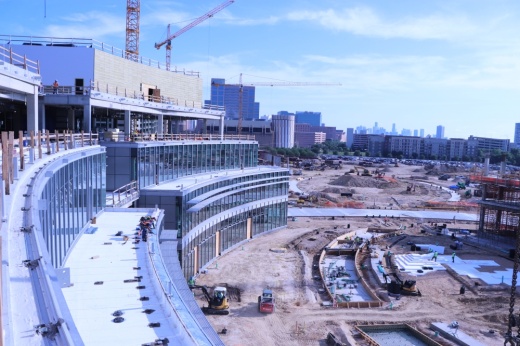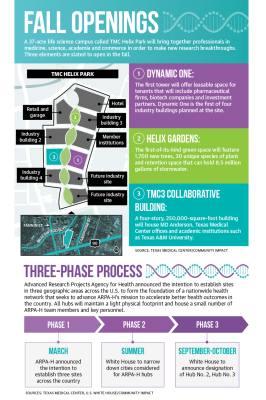This fall, in the heart of the Texas Medical Center, officials are preparing to open Phase 1 of TMC Helix Park, a 37-acre collaborative research center that will boast large-scale commercial developments and an economic impact officials project to be around $5.4 billion.
Backed by $1.8 billion in investments for the first phase, the park aims to bring together professionals in medicine, science and academia focused on making new medical research breakthroughs. The life science campus will also offer more than 6 million square feet of research labs, retail and hotel facilities.
"It’s a place open to the community, a place for the community to come and learn about things happening in the medical center,” said Ashley McPhail, TMC chief external affairs and administration officer. “[You can] come here each day with the latest entrepreneurs from the institutions.”
Amid facility expansions and growth, TMC leadership and officials within various medical institutions also have thrown their hat in the ring as one of the sites for a new federal research hub.
The Advanced Research Projects Agency for Health, or ARPA-H, would focus on driving innovative research in an effort to transform the treatment, prevention and early detection of cancer and other diseases, according to White House information. The hope, officials said, is to speed up the process by which new medical breakthroughs can be implemented at the patient level.
President Joe Biden presented the details of ARPA-H in March 2022 as part of Biden’s Cancer Moonshot program. The U.S. government’s fiscal year 2023-24 budget includes $2.5 billion that will go toward research and operations at the ARPA-H facility, a funding infusion that could benefit other research already underway.
Wenshe Liu is the director of the Texas A&M University Drug Discovery Laboratory and a professor of chemistry at Texas A&M University—one of two Texas organizations that expressed interest in working with the ARPA-H programs. He said if the hub doesn’t come to Texas, it would be a big economic loss.
“ARPA-H is supposed to bring in a lot of research funding,” Liu said. “It will support research activity here and increase job opportunities for people in Texas. Long term, it’s a huge economic impact to the local [economy] because if you bring an ARPA-H hub and develop novel techniques, they will be commercialized locally and create spin-off companies.”
Three parts, one location
If Houston is chosen for the ARPA-H facility, McPhail said it would be located within the Texas Medical Center’s Helix Park, located off Old Spanish Trail. The first phase of Helix Park will open this fall, McPhail said.
The first phase of Helix Park includes three parts. The first is a collaborative research building, a four-story building on the western side of the campus that will host research initiatives for MD Anderson, Texas A&M University Health Science Center, The University of Texas Health Science Center and TMC.
The second, which will open to the public this fall, is the first tower of the Dynamic One building. At least 368,000 square feet of commercial and institutional research space toward the north of the campus will be anchored by retail and restaurants.
The Baylor College of Medicine will occupy three floors of Dynamic One with two floors dedicated to academic scientific research, officials said.
“Having a place where our clinical programs are located, where our data scientists are, next to a biotech development center, and having our medical students all integrated into that environment will allow them to be ready in the future for where health care is going,” Baylor President Paul Klotman said in a news release.
The third piece of Phase 1 is the TMC Helix Gardens, 300,000 square feet of public green space formed in the shape of a DNA helix down the center of the campus. The gardens will have six public parks, each approximately the size of a football field.
Roughly 1,700 new trees were installed in May across Helix Park, which stretches 11 city blocks in total, connected by streets, sidewalks and bike lanes.
With the economic and environmental additions emerging in Houston as TMC Helix Park makes its way, existing facilities like the TMC Innovation building also contribute to the comprehensive ecosystem, McPhail said. The TMC Innovation building, located nearby off Holcombe Boulevard, hosts more than 300 health care startups fueled by entrepreneurs and innovators in health care.
An ambitious recognition
Officials with ARPA-H announced a national site selection process would occur to choose three different U.S. hubs where ARPA-H agencies would be located.
The agency designated Washington, D.C., as hub site No. 1 on March 15. It will focus on stakeholder operations since it is located in the nation’s capital with regulatory and legislative partners, ARPA-H officials said.
The locations of the second and third hubs are out for bid. Hub No. 2 is where ARPA-H researchers would use a proactive approach to enhance clinical trials by reaching a variety of patient populations to capture data for future research. Hub No. 3, called an “investor catalyst,” would help researchers navigate business and regulatory landscapes and connect with investment dollars to bring new innovations to market.
“The idea is to dream big, recognizing that most big ideas are going to fail,” said Thomas Graham, a spokesperson for the Coalition for Health Advancement and Research, a group formed after Biden’s announcement with the goal of bringing the facility to Texas. “But those big ideas, when they do succeed, they succeed big.”
Houston is seeking consideration for Hub No. 2, McPhail said. TMC’s unique ecosystem, research, talent, faculty, commercialization and diversity all serve as reasons for why the city would make a good spot for the hub, she said.
With the goal of improving patient outcomes, having a diverse population of patients to draw from—one that mirrors the vast range of different socioeconomic situations across the U.S.—can be helpful to researchers, Liu said. The TMC has a unique geolocation, he said, that covers a large area with a mixed population of Caucasians, Hispanic people, African-Americans and Asian people.
“A diverse population of patients will help understand disease development in different ethnic groups that can help devise different approaches in treatment,” Liu said.
As of press time, May 30, a decision on which cities would make it to round two with a site visit of ARPA-H consideration was expected to be announced sometime in early summer.
Shawn Arrajj contributed to this report.






